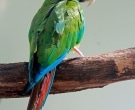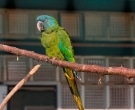Of 41 cm.. length and a weight which varies between 207 and 294 g..
The rare and beautiful Blue-headed Macaw (Primolius couloni), with its striking and vivid plumage Green and blue, Unfortunately, now hardly seen in nature.
As its common name suggests, the head is blue, the forecrown with a narrow band of black color that will fade in blue on the area of the crown; the ear-coverts and both sides of the neck are blue, fading to green in the area of the nape. Upperparts olive green with light tint in the tail and in the uppertail-coverts. Small, large and medium-sized coverts green interiors; the large coverts Blue exterior. The flight feather are blue top (with a bit of green in high schools), by below, Yellow olive. Underparts green, slightly more yellow than the upper. The upper part of the tail is an intense Brown, while the underparts is yellowish-green.
The bill is black, Ivory at the end; the bare skin of the lores and the top of the cheeks is gray with bluish and dye crossed ahead by very small lines of black feathers: the irises yellow; legs grayish pink.
Both sexes are similar, the male, possibly, largest average.
The immature with the irises dark. The bill is completely black and the legs more grey. The skin of the face and lores (area between the beak and eyes) is white. Depending on your age, have queues shorter.
NOTE:
-
In close relationship with the Yellow-collared Macaw (Primolius auricollis) and the Blue-winged Macaw (Primolius maracana); It was sometimes considered congener with the latter. Monotypic.
- Sound of the Blue-headed Macaw.
The Blue-headed Macaw distributed by tropical rainforests, at altitudes between 150 and 1,550 m. They prefer habitats altered or partially open, mainly on the edges of forest along the rivers, in the clearings and in partially wooded areas surrounding; There are also records of these macaws in marshy areas of forest with Mauritia Palms.
This species prefers possibly the wooded foothills of lowlands.
He is not very sociable: The flocks with larger number of individuals occur between June and October, usually traveling in pairs or groups of three individuals; apparently, not associated with the Chestnut-fronted Macaw.
Known that the reproduction of these birds is correlated with the period of greatest abundance of food due to the breeding of pigeons (before and after leaving the nest) It requires a lot of energy expenditure.
Records of their reproductive period are not, However there has been during the months of April to June shown to the parents with their chicks and that in Peru, species Mauritia flexuosa “Guaje” and Dipterix odorata “odorata” they are key to your reproduction.
In captivity they reproduce couples chosen by them and have of two to three eggs, two chicks being generally viable.
The Blue-headed Macaw they feed mainly on seeds, mature and immature fruit, and flowers, occasionally supplemented with bark and other inputs.
Unlike many other birds, the parrots of the New world They seem to not be able to modify your diet to predominately insectivora, reason why are intimately linked to the patterns of flowering and fruiting (Brightsmith et to the, 2008). They have a strong dependency of the colpas clay.
Distributed by the Western basin of the Amazon at the West end of Brazil (in Acre, from time to time), Peru Eastern and in the Northwest corner of Bolivia.
In Peru are known from the top of the Valley of the Huallaga River in Loreto, San Martin and Huanuco (including the outskirts of Tingo Maria), in a town on the eastern slope of the National Park of the Sierra of the Divisor in the basin Ucayali, in the basins of the Curanja River and Purus River, in the Apurímac River in the Cuzco and Mother of God to the West of Puerto Maldonado, around Puerto Maldonado and the Tambopata River to 50 km of the border with Bolivia; You can see in the Manu National Park.
In Bolivia have been found in Peace and perhaps in the South of Beni with indications that the birds are distributed regularly to the South, in the Eastern foothills of the Andes to the South of Bolivia.
Local and erratic in its distribution, but apparently quite common in some places. Perhaps the enlargement of its range is fairly limited in the southwest of the Amazon due to the degradation of forests.
Rare in captivity.
• Red list category of the UICN current: Vulnerable
• Population trend: Decreasing
Until recently it was considered fairly common, but a review in 2006 by BirdLife International suggested that it was rare, with a decrease in the total population to the 1.000-2.500 individuals. For this reason, It has been put into the category in danger of extinction in the 2007 (Red list of the UICN).
Parts of the distribution of this species are still little known, but Tobias and Brightsmith (2007) It has been suggested that the previous estimates were too low, with the likely real number of 9.200 to 46.000 mature individuals. It is suggested that vulnerable It could be a category more appropriate for this species.
The Blue-headed Macaw commonly found in the markets of Brazil, still valuable, prices above the 12.000 $, and in high demand due to their rarity.
OBJECTIVES:
Information about the actual state of conservation of the species. In addition, This project, that is being conducted under a partnership with the Government of Peru, includes other project, in this case for the conservation of the Grey-cheeked Parakeet, catalogued as “in danger”.
STRATEGIES:
The two projects include the definition of methods for determining the density of populations in key places, the evaluation of the level of the illegal trade in birds, and the promotion of the local social consciousness in relation to the illicit trade of these species.
ACTIONS:
The field team is carrying out assessments of populations and habitat analysis, and at the same time they updated the assessment of the threats weighing on the two species. The general population trend of the Blue-headed Macaw is one very gradual decrease, but it seems that the species can withstand certain levels of their forest habitat change. By censuses in consecutive years, the population of the Grey-cheeked Parakeet It has not undergone further decline despite the severe fragmentation of the preferred dry forest.
Very rare in captivity.
Couples are formed according to the preferences of the copies, couples chosen by the breeder will not work. The diet is based on the seasonal fruits and vitamin supplements.
The Parque de las Leyendas Zoo in Peru, captive breeding, It has no objective reproduction but the exhibition of animals that are twelve in total. Births have been but manualâ studies have not been performed. In the month of March to April of the 2010, This project through the SERNANP quoted Zoo scientific staff conducted the studies of biometrics of this species and are establishing the protocols for the reproduction studies.
Are no data about your longevity, Although similar species such as the Blue-winged Macaw have records having lived 31 years in captivity and having raised from the 6 years of age.
The illegal traffic This species is a serious problem that affects their conservation.
- Blue-headed Macaw, Blue headed Macaw, Coulon's Macaw (inglés).
- Ara de Coulon (francés).
- Blaukopfara (alemán).
- maracanã-de-cabeça-azul (portugués).
- Guacamayo Cabeciazul, Maracaná de Cabeza Azul, Guacamaya cabeza azul (español).
- Parabachi cabeza azul (Colombia).
- Guacamayo de Cabeza Azúl (Perú).

- Orden: Psittaciformes
- Familia: Psittacidae
- Genus: Primolius
- Nombre científico: Primolius couloni
- Citation: (Sclater, PL, 1876)
- Protónimo: Ara couloni
————————————————————————————————
Blue-headed Macaw (Primolius couloni)
Sources:
– Avibase
– Parrots of the World – Forshaw Joseph M
– Parrots A Guide to the Parrots of the World – Tony Juniper & Mike Parr
– Birdlife
– Photos:
(1) – Blue-headed Macaw in the Walsrode Bird Park, Germany By Quartl (Own work) [CC BY-SA 3.0], via Wikimedia Commons
(2) – Blue-headed Macaw (also known as Coulon’s Macaw) in captivity at Walsrode Bird Park, Germany By Robert01 (Self-photographed) [CC BY-SA 3.0 of], via Wikimedia Commons
(3) – Blue-headed Macaw (Primolius couloni) at Jungle Island of Miami By DickDaniels (http://carolinabirds.org /) (Own work) [GFDL or CC BY-SA 4.0-3.0-2.5-2.0-1.0], via Wikimedia Commons
(4) – Moscow Zoo. Blue-headed Macaw (Ara couloni, syn. Primolius couloni) By Корзун Андрей (Kor!An) (Own work) [GFDL or CC BY-SA 3.0], via Wikimedia Commons
(5) – Ara couloni – Wikipedia
– Sounds: (Xeno-canto)





